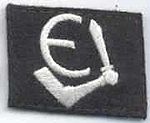K.e.coffman (talk | contribs) Update tag |
K.e.coffman (talk | contribs) →Formation: I assume this was the intended link, not the Soviet formation |
||
| Line 42: | Line 42: | ||
The new 3rd Estonian SS Volunteer Brigade had by November 1943, 5,099 men and was ready for active service. In October the brigade was first allocated anti-[[Partisan (military)|partisan]] duties in northern [[Belarus]] where it it was engaged in operations against the [[Rossony Partisan Republic]]. At the end of October, the [[Red Army]] broke through the German lines after intense fighting in the nearby Nevel section of the front. Since the German command had no reserves in the area, the Estonian Brigade was transferred to the front-line where it pushed the Soviet forces back 5-15 kilometers by 13 November.<ref>Jüri Remmelgas (1955) (in Estonian). ''Kolm kuuske (The Three Spruces)''. Stockholm: Kirjastus EMP. pp. 153-172.</ref> |
The new 3rd Estonian SS Volunteer Brigade had by November 1943, 5,099 men and was ready for active service. In October the brigade was first allocated anti-[[Partisan (military)|partisan]] duties in northern [[Belarus]] where it it was engaged in operations against the [[Rossony Partisan Republic]]. At the end of October, the [[Red Army]] broke through the German lines after intense fighting in the nearby Nevel section of the front. Since the German command had no reserves in the area, the Estonian Brigade was transferred to the front-line where it pushed the Soviet forces back 5-15 kilometers by 13 November.<ref>Jüri Remmelgas (1955) (in Estonian). ''Kolm kuuske (The Three Spruces)''. Stockholm: Kirjastus EMP. pp. 153-172.</ref> |
||
The Brigade was put under command of the [[ |
The Brigade was put under command of the [[VIII Army Corps (Wehrmacht)|VIII Corps]] of [[Army Group North]]. The brigade suffered severe losses fighting against numerous Red Army assaults and was eventually forced back to [[Opochka]] and transferred to the I Army Corps. It was then decided to create an Estonian Division and use the Brigade to form the cadre of the 20th Waffen Grenadier Division der SS (Estonian Number 1). |
||
==Expansion== |
==Expansion== |
||
Revision as of 08:06, 10 March 2016
| 3rd Estonian SS Volunteer Brigade | |
|---|---|
 Insignia of Estonian SS Volunteer Brigade | |
| Active | December 1943 - March 1944 |
| Country | |
| Allegiance | Adolf Hitler |
| Branch | |
| Size | Brigade |
| Engagements | World War II |
| Commanders | |
| Notable commanders | Franz Augsberger |
The 3rd Estonian SS Volunteer Brigade (German: 3. Estnische SS Freiwilligen Brigade) was a formation of the German Waffen SS during World War II. It was formed in May 1943, when the Estonian SS Legion (Estnische SS Legion), which was still undergoing formation in Dębica, (called Heidelager in 1943), was upgraded. The first name chosen for the brigade was the Estonian SS Volunteer Brigade, until October 1943, when all SS brigades were numbered so it finally became the 3rd Estonian Volunteer Brigade. The brigade was expanded to a division and renamed on January 23, 1944.
Formation
The Estonian SS Legion had by April 1943, increased its numbers enough to form a brigade sized formation and was even able to dispatch a battalion, the Narva Battalion, to the 5th SS Panzer Division Wiking to replace the departing Finnish Battalion whose members had come to the end of their contracts.
The new 3rd Estonian SS Volunteer Brigade had by November 1943, 5,099 men and was ready for active service. In October the brigade was first allocated anti-partisan duties in northern Belarus where it it was engaged in operations against the Rossony Partisan Republic. At the end of October, the Red Army broke through the German lines after intense fighting in the nearby Nevel section of the front. Since the German command had no reserves in the area, the Estonian Brigade was transferred to the front-line where it pushed the Soviet forces back 5-15 kilometers by 13 November.[1]
The Brigade was put under command of the VIII Corps of Army Group North. The brigade suffered severe losses fighting against numerous Red Army assaults and was eventually forced back to Opochka and transferred to the I Army Corps. It was then decided to create an Estonian Division and use the Brigade to form the cadre of the 20th Waffen Grenadier Division der SS (Estonian Number 1).
Expansion
The brigade was expanded to a division and renamed the 20th Estonian SS Volunteer Division on January 23, 1944.[2] It was returned to Estonia after the general conscription call where it was reformed into the 20th Waffen Grenadier Division of the SS (1st Estonian) established on May 26, 1944,[2] when it absorbed all the other Estonian formations in the German military and some Estonian police units. The Finnish Infantry Regiment 200 was also assimilated.[2]
Commander
- Obersturmbannführer Franz Augsberger (22 October 1943 - 21 January 1944)
Order of battle
- SS Volunteer Regiment 42 (renumbered 45 in November 1943)
- I Battalion
- 3 x Companies
- 1 x Heavy Company
- II Battalion
- 3 x Companies
- 1 x Heavy Company
- 13th (7.5 cm leichtes Infanteriegeschütz 18) Kompanie
- 14th (5 cm PaK 38 anti tank) Kompanie
- SS Volunteer Regiment 43 (renumbered 46 in November 1943)
- I Battalion
- 3 x Companies
- 1 x Heavy Company
- II Battalion
- 3 x Companies
- 1 x Heavy Company
- 13th (7.5 cm leichtes Infanteriegeschütz 18) Kompanie
- 14th (5 cm PaK 38 anti tank) Kompanie
- 15th Pionier Kompanie
- SS Flak Battalion 53
- 1 Battery (2 cm FlaK 30)
- 2 Battery (3.7 cm FlaK 43)
- 3 Battery (88 mm gun)
- SS Panzerjäger Battalion 53
- SS Signals Company 53'
- SS Field Medical Battalion 53
- SS Artillerie Battalion 53
- Headquarters Battery
- 3 x Batteries
- SS Training and Reserve Regiment 33